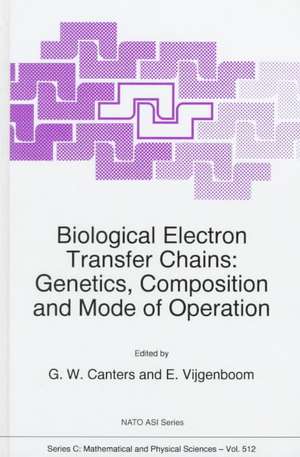Biological Electron Transfer Chains: Genetics, Composition and Mode of Operation: NATO Asi Series. Series C, Mathematical and Physical Science, cartea 512
Autor Gunter Dueck Editat de G. W. Canters, E. Vijgenboomen Limba Engleză Hardback – 31 mai 1998
Din seria NATO Asi Series. Series C, Mathematical and Physical Science
- 15%
 Preț: 591.29 lei
Preț: 591.29 lei - 5%
 Preț: 779.53 lei
Preț: 779.53 lei - 15%
 Preț: 582.91 lei
Preț: 582.91 lei - 15%
 Preț: 584.71 lei
Preț: 584.71 lei - 15%
 Preț: 580.46 lei
Preț: 580.46 lei - 15%
 Preț: 586.37 lei
Preț: 586.37 lei - 15%
 Preț: 586.02 lei
Preț: 586.02 lei - 15%
 Preț: 588.00 lei
Preț: 588.00 lei - 15%
 Preț: 702.54 lei
Preț: 702.54 lei - 15%
 Preț: 596.65 lei
Preț: 596.65 lei - 15%
 Preț: 588.97 lei
Preț: 588.97 lei - 15%
 Preț: 592.71 lei
Preț: 592.71 lei - 15%
 Preț: 584.71 lei
Preț: 584.71 lei - 15%
 Preț: 592.71 lei
Preț: 592.71 lei - 15%
 Preț: 578.84 lei
Preț: 578.84 lei - 15%
 Preț: 600.80 lei
Preț: 600.80 lei - 15%
 Preț: 583.75 lei
Preț: 583.75 lei - 15%
 Preț: 599.61 lei
Preț: 599.61 lei - 15%
 Preț: 597.30 lei
Preț: 597.30 lei - 15%
 Preț: 595.69 lei
Preț: 595.69 lei - 15%
 Preț: 599.14 lei
Preț: 599.14 lei - 15%
 Preț: 587.35 lei
Preț: 587.35 lei - 15%
 Preț: 590.96 lei
Preț: 590.96 lei - 15%
 Preț: 605.49 lei
Preț: 605.49 lei - 15%
 Preț: 592.90 lei
Preț: 592.90 lei - 15%
 Preț: 594.85 lei
Preț: 594.85 lei - 15%
 Preț: 595.86 lei
Preț: 595.86 lei - 15%
 Preț: 600.58 lei
Preț: 600.58 lei - 15%
 Preț: 708.61 lei
Preț: 708.61 lei - 15%
 Preț: 590.77 lei
Preț: 590.77 lei - 15%
 Preț: 697.32 lei
Preț: 697.32 lei - 15%
 Preț: 595.36 lei
Preț: 595.36 lei
Preț: 653.87 lei
Preț vechi: 688.28 lei
-5% Nou
Puncte Express: 981
Preț estimativ în valută:
125.12€ • 130.38$ • 103.60£
125.12€ • 130.38$ • 103.60£
Carte tipărită la comandă
Livrare economică 03-17 aprilie
Preluare comenzi: 021 569.72.76
Specificații
ISBN-13: 9780792351382
ISBN-10: 079235138X
Pagini: 304
Dimensiuni: 160 x 240 mm
Greutate: 0.6 kg
Editura: Kluwer Academic Publishers
Seria NATO Asi Series. Series C, Mathematical and Physical Science
Locul publicării:Dordrecht, Netherlands
ISBN-10: 079235138X
Pagini: 304
Dimensiuni: 160 x 240 mm
Greutate: 0.6 kg
Editura: Kluwer Academic Publishers
Seria NATO Asi Series. Series C, Mathematical and Physical Science
Locul publicării:Dordrecht, Netherlands
Public țintă
ResearchCuprins
Preface. 1: Biological Electron Transfer. Respiratory Electron Transfer Chains; P.L. Dutton, et al. Protein-Mediated Electron Transfer: Pathways, Orbital Interactions, and Contact-Maps. Structure-Function Relations for Protein Electron Transfer; D.N. Beratan, S.S. Skourtis. Coupling of Electron Transfer and Protein Dynamics; A.I. Kotelnikov, et al. Recent Surprises in the Study of Photoinduced Electron Transfer: Covalent versus Non-Covalent Pathways; J.W. Verhoeven, et al. Mechanisms and Control of Electron Transfer Processes in Proteins; O. Farver, I. Pecht. 2: Redox Chains: Composition and Control. The Paracoccus denitrificans Electron Transport System: Aspects of Organisation, Structures and Biogenesis; S.J. Ferguson. Genetics and Regulation of C1 Metabolism in Methylotrophs; M.E. Lidstrom, et al. Hierarchical Control of Electron-Transfer; H.V. Westerhoff, et al. On the Mechanism of Nitrite Reductase: Complex between Pseudoazurin and Nitrite Reductase from A. Cycloclastes; M.E.P. Murphy, et al. Structural Research on the Methylamine Dehydrogenase Redox Chain of Paracoccus denitrificans; F.S. Matthews, et al. 3: Oxido-Reductases: Structure and Function. Microbial Amine Oxidoreductases. Their Diversity, Role, Structure and Mechanism; J.A. Duine, A. Hacisalihoglu. Flavocytochromes: Nature's Electrical Transformers; S.K. Chapman, et al. The Chemistry of Biological Denitrification. Spectroscopic Studies Provide Insights into the Mechanism of Dissimilatory Heme cd1 and Copper-Containing Nitride Reductases; B.A. Averill, et al. Cytochrome c Nitrite Reductase from Sulfospirillum deleyianum and Wolinella succinogenes. Molecular and Spectroscopic Properties of the Multihaem Enzyme; O. Einsle, et al. Molecular Basis for Energy Transduction: Mechanisms of Cooperativity in Multihaem Cytochromes; R.O. Louro, et al. The Solution Structure of Redox Proteins and Beyond; L. Bianci, et al. 4: The Cytochrome c Oxidase Family. Exploring the Proton Channels of Cytochrome Oxidase; R.B. Gennis. Control of Electron Transfer to the Binuclear Center in Cu-Heme Oxidases; M. Brunori, et al. Chimeric Quinol Oxidases Expressed in Paracoccus denitrificans; C. Winterstein, et al. Superfamily of Cytochrome Oxidases; M. Saraste, et al. The Electron Transfer Centers of Nitric Oxide Reductase: Homology with the Heme-Copper Oxidase Family; A. Kannt, et al.
